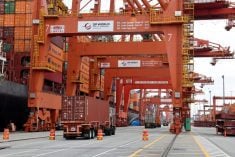SYDNEY, Nov 10 (Reuters) – Heavy rains that hit Australia’s east coast last week are not expected to cause large-scale quality downgrades to wheat across the nation’s second-largest producing state, traders said on Tuesday.
As much as 100mm of rain fell across New South Wales, data from the Australian Bureau of Meteorology shows, stoking fears of quality downgrades to as much as half the crop – reminiscent of 2011, when heavy rainfall reduced half the region’s wheat to feed-quality grain.
Damage will likely be confined to about 1.5 million tonnes, about 25 percent of the crop, traders said, however any grain damaged will still remain desirable as a food staple.
Read Also

Canadian trade data delayed by U.S. government shutdown
Canadian international trade data for September will be delayed indefinitely due to the ongoing partial shutdown of the United States government, Statistics Canada said Friday, Oct. 24.
“There will be some damage. However, assuming it stops raining and farmers can get a clean crack at harvest, I don’t see it being a major feed wheat event,” said Matthew Pattison, trading manager at Nidera Australia.
“Maybe 1 million to 1.5 million tonnes of wheat will be downgraded. That doesn’t necessarily mean it will be (reduced to) feed quality.”
Too-much rain just before harvest can damage wheat, with poor quality crops being used for animal feed.
Australia’s chief commodity forecaster in September estimated New South Wales wheat production at 7.2 million tonnes, out of a total forecast for Australian output of 25.3 million tonnes.
But dry weather since that report has meant most traders and analysts expected New South Wales wheat production to fall well below six million tonnes.
The avoidance of large-scale Australia production shortfalls will further pressure the global wheat benchmark, which on Monday hit a two-week low amid ample global supply.
Although the fortunes of Australia’s east coast wheat production has brightened, analysts noted there are still forecasts for more rains later this week.
Some small areas of New South Wales may receive 50mm more rain, the Australian weather bureau said, but the majority of the state will likely see just light showers.
Farmers will likely accelerate the wheat harvest to avoid production issues, analysts said.














